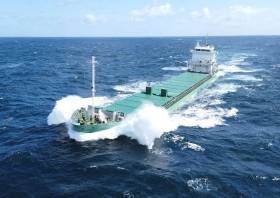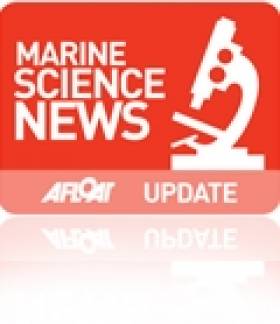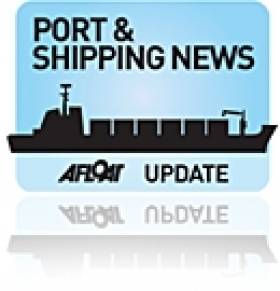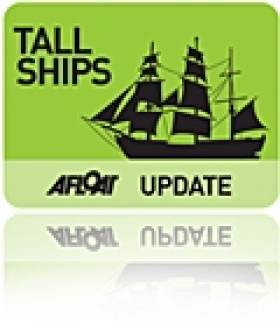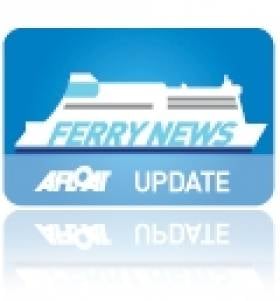Displaying items by tag: Bay of Biscay
Five Injured Crew Airlifted From Irish Cargo Ship In Bay Of Biscay
Five crew were evacuated from an Irish cargo vessel yesterday (Tuesday 10 December) after encountering rough seas in the Bay of Biscay, as Maritime Bulletin reports.
The Arklow Day has previously left Aviles Port in northwest Spain on Monday evening (9 December) after offloading its cargo but sailed into challenging conditions, with waves reportedly nine metres high.
One of these waves struck five of the vessel’s 10 crew, believed to have been on deck in the open at the time, who were left with ‘serious’ injuries.
The wounded seamen were airlifted to hospital by a Spanish rescue helicopter while the remaining five crew took the ship to the nearest port at El Musel on the Cantabrian coast.
The Arklow Day was acquired by Arklow Shipping from the Flinter Group two years ago, as previously reported on Afloat.ie. The 132m vessel, previously known as Flinter Aland, has a 13,008m3 hold capacity and a speed of 12 knots.
Marine Institute Brings Underwater TV Survey Tech To Bay Of Biscay
#MarineScience - The first underwater TV (UWTV) survey of the Bay of Biscay Nephrops grounds was carried out on the RV Celtic Voyager from 20-29 September.
This survey involved collaboration between the fishing industry and IFREMER, the French equivalent of the Marine Institute. The Celtic Voyager was chartered for this survey by the French fishing industry (CNPMEM).
The team of French scientists from Lorient were trained in the UWTV survey methodology by Jennifer Doyle, an expert from the Marine Institute. A fishing industry observer also participated in the survey.
This was the furthest south that the Irish Celtic Voyager research vessel has been to at 45°55′N 2°22′W.
The Bay of Biscay Nephrops grounds, known locally as 'la Grande Vasière', have an area of approximately 11,600 sqkm and support landings of Neprophs (better known as Dublin Bay prawns or langoustines) of around 4,000 tonnes annually.
During the 10-day survey, 160 UWTV stations were successfully completed with an average depth of 100 metres. At each station a sled-mounted camera system is towed at 1 knot. This allows for the detailed examination of the sea bed. The Nephrops burrows on the video footage collected are identified and counted by trained and experienced scientists.
Weather conditions throughout were perfect for TV operations with light winds, little or no swell and sea surface temperature around 20 degrees C. The visibility at the seabed was also excellent. The results from this survey will be analysed by IFREMER scientists to determine stock abundance.
The Marine Institute have been developing UWTV survey methods and technology since 2002. Since then, survey coverage has been expanded: in 2014 the main Nephrops stocks fished in Irish waters are have all been fully surveyed – Aran Grounds, Porcupine Bank, Western Irish Sea, Eastern Irish Sea, South Coast, Smalls, Labadie, Jones and Cockburn Banks.
These UWTV surveys form the cornerstone of the ICES assessments and management advice. The results of the TV surveys directly form the basis of the catch options.
All UWTV Marine Institute surveys reports are available online in the Marine Institute's open access repository.
Irish Managed Cargoship Sinks Following Collision with Tanker
#PORTS & SHIPPING - Seven-crew have been saved from Florece (PHOTO) an Irish managed general cargoship which sank off the UK, following a collision with a Greek owned chemical tanker on Friday, according to www.tradewinds.no
The accident took place in the Bay of Biscay, approximately 250 miles from Land's End, the UK's Maritime and Coastguard Agency said. The Dominican flagged Florece (1990/1,960grt) which is managed by Greystones based Berg Maritime Management, sank after the 88m vessel was in collision with the 53,081-dwt tanker Afrodite, operated by Tsakos.
The crew of the Florece abandoned ship, taking to two life rafts, before being rescued by the 8,040 containership capacity Ocean Titan, operated by Pacific-Gulf Marine of the US.
Afrodite had attempted to deploy a rescue craft but was unsuccessful because of the sea swell. Falmouth Coastguard helped co-ordinate the rescue operation with Spanish counterparts to rescue the crew of Florece, a mix of Russians, Polish and Ukrainians. The 187m Afrodite was not reported as taking on water.
Mauritius-Bound Ferries Finally Bid Galway Farewell
First to be loaded was the Clann na nOileáin on Wednesday in an operation than took four-hours while on Friday her sister Clann Eagle I took six-hours to be winched safely onto the cargo-deck during freshening winds.
It is ironic that since Thor Gitta 's arrival to the port's Dún Aengus Dock on 5 April that it would also nearly be the same time taken for the estimated 25-day delivery voyage of the ferries to the Indian Ocean island.
During the 8,300 mile journey Thor Gitta will make several port of calls with the first call to La Rochelle. The Bay of Biscay port is the next largest port south of Les Sables d'Olonnes, where the fast-ferries where built at the OCEA boatyard for her original owners Bád Arann Teoranta which traded as Aran Direct on routes from Rossaveal to the islands.
Thor Gitta was built in 1996 and is also designed to carry 364 TEU (twenty-foot equivilant unit) containers and belongs to an-eight strong fleet operated by the Danish company, Thor Rederi A/S of Svendborg.
One of the reasons why the heavylift vessel was delayed in loading was to ensure the correct positioning of the ferries so not to further disrupt other port call cargo allocation while on the long repositioning voyage to Mauritius.
The 4,078 tonnes cargsoship is also scheduled to make en-route calls to Pointe Noir in the Congo, Cape Town and Pemba in Mozambique before finally reaching the southern Indian Ocean destination.
When the ferries were completed in 2005 and 2006 they were valued between €5-6m but they only served up to September 2008 when the 243 passenger aluminium built craft were laid-up at the Connemara harbour due to financial difficulities.
This led to the company going into receivership and the vessels were put up for auction in Galway last February. Despite bids reaching €950,000, they were withdrawn at the auction hosted by the Cork based auctioneer, Dominic J. Daly.
In the following month the fast-ferries were sold to the French owner for a new career based from the island state which is in the Mascarene Islands. Mauritius is neighboured by the smaller islands of Agalega, Cargados Carajos, Rodrigues and the French island of Réunion some 200km to the southwest.
Sail Training Ireland Assumes Mantle of Asgard
Writing in the Irish Independent on Saturday, WM Nixon welcomes the introduction of Sail Training Ireland as a big step towards getting Ireland back into tall ship sailing.
Nixon also pays tribute to Ireland's previous square-rigger, Asgard II, which held its own among taller competitors for almost three decades before its sinking in the Bay of Biscay in 2008.
That ship was also remarkable for being "one of the very few government owned and run sail training ships in the world".
In the wake of Asgard II, a new approach is being taken with Sail Training Ireland - which is an officially recognised voluntary trust, actively supported by the Irish Sailing Association, that is open to anyone and free to accept donations and corporate endowments.
"The sailing community and all those interested in promoting maritime affairs now have an opportunity for self-reliance," writes Nixon, who notes that while we get back on the road to having our own tall ship, Sail Training Ireland will be able to place Irish trainees on other ships already sailing for invaluable experience.
Irish Sea 'Racehorse' Returns
Dawn Merchant and Brave Merchant represented the first pair of the 'Racehorse' class quartet of ro-pax sisters commissioned for the Cenargo Group. The quartet were built by Spainish shipbuilders Astilleros Espanoles SA in Seville, noting the first pair at 22,046grt where slightly smaller in tonnage terms compared to their 22,215grt counterparts Midnight Merchant and Northern Merchant. Upon delivery in 2000 the second pair were chartered to Norfolkline's Dover-Dunkerque route.
With a 130 truck capacity the Norman Trader can handle a marginally higher number of freight vehicles compared to the Norcape which handled 127 trucks. The Norcape, a 32-year-old freight-only vessel,was stood down in February and remains laid-up at Liverpool's Huskisson Dock. Incidentally, Norman Trader has joined one of her Racehorse class sisters, European Endeavour (formerly Midnight Merchant) which had directly replaced the Norcape on the central corridor route.
Likewise the European Endeavour is no stranger to the Irish route as for the last two years she has acted as winter relief vessel to cover the refits of the routes Dutch built ro-pax sisters Norbay and Norbank. The latter vessel is now undergoing a refit by Cammell Laird Shiprepairers in Birkenhead, now that the Norman Trader is in service to maintain the three-ship operated 8-hour route.
The Norman Trader had arrived into Dublin Bay last Friday from London's Tilbury Docks, on the next day she entered Dublin Port. In recent years she has operated on English Channel routes for the French shipping giant Louis-Dreyfus Armateurs through their ferry division LD Lines.
Norman Trader's (Dawn Merchant) sister Brave Merchant now renamed Norman Bridge also runs for LD Lines 'Motorways of the Seas' (MOS) route across the Bay of Biscay between Nantes /St. Nazaire to Gijón in northern Spain. The 14-hour route which started last year, which was run iniatially as a joint venture between Grimaldi Lines and Louis-Dreyfus and traded as GLD Atlantique.
- Dublin Port
- Bay of Biscay
- irish sea
- Ports and Shipping News
- Birkenhead
- Norcape
- RoPax
- DublinLiverpool
- Norfolkline
- FreightFerry
- Motorways of the Sea
- Norbank
- Norbay
- MOS
- European Endeavour
- Central Corridor
- P&O Irish Sea
- Norman Trader
- LD Lines
- Merchant Ferries
- Cenargo Group
- RaceHorse Class
- Tilbury Docks
- Cammell Laird
- Aintree
- Grand National
- Aintree Grand National
Brittany Ferries Re-Open Bilbao Route
The Cap Finistere has a 790 passenger / 500 vehicle capacity and the vessel will operate two round trips weekly with each crossing taking 24 hours. Interestingly an additional en-route call to Roscoff is scheduled on Sunday sailings bound for Bilbao which will take 33-hours. This is to facilitate a crew change, as the Cap Finistere does not operate on any of the company routes from France.
In 2009 the P&O service carried 180,000 passengers and 193,000 in 2008 but closed due to "unsustainable losses". There were 800 redundancies but some 150 staff jobs were secured through transfer. Click here for a previous posting. The company were in direct competition with Brittany Ferries existing two routes between Plymouth and Poole to Santander.
The Bilbao route brings the Brittany Ferries operations to five sailings weekly between the UK to Spain, two from Portsmouth to Santander and a single round-trip to Plymouth.
The Pride of Bilbao was sold late last year by ICG to the Baltic Sea based St. Peter Line at a profit of €9.4m. The vessel underwent refurbishment and was renamed Princess Anastasia and next month starts a new St. Petersburg-Stockholm service, with Russian bound sailings calling en route to
the Estonian capital of Tallinn. Click here for more details.
Pride of Bilbao's return to the Baltic is nearly full-circle as the 2,553 passenger / 600 vehicles vessel, built in 1986 as Olympia for Viking Line's also operated out of Stockholm to Helsinki, and at the time was one of the largest overnight passenger capacity ferries in the world.
Bilbao Returns to Baltic Sea 'Roots'
For the last 17 years the Pride of Bilbao has operated between Portsmouth and Bilbao under charter to P&O. Built in 1986, she was launched as Olympia for Viking Line between Stockholm and Helsinki, then the Baltic Sea ferry was one of the largest overnight passenger capacity ferries in the world. At 177 metres long the vessel can accommodate 2552-passengers, 600-vehicles and space for 77-trucks. She has a sister, the Mariella, which currently operates on Viking Line's Stockholm-Mariehamn–Helsinki service.
In 1993 the vessel was renamed Pride of Bilbao and launched a new service on the Bay of Biscay, under charter from her Scandinavian owners. The following year ICG purchased the Pride of Bilbao from Viking Line and she was re-registered to the Bahamas. The vessel was subsequently entered into a British bare-boat charter arrangement between P&O Ferries and ICG. Due to unsustainable losses the route closed on 28 September this year but rivals Brittany Ferries soon shortly announced they would reopen the route in Spring 2011.
Throughout the Pride of Bilbao's career under ICG (parent company of Irish Ferries), the cruiseferry has only once visited Ireland. In between Spanish sailings, she was sub-chartered for a three-day Christmas mini-cruise from Portsmouth to Dublin in 2004, where the Pride of Bilbao berthed at the ferryport close to the ICG headquarters.



























